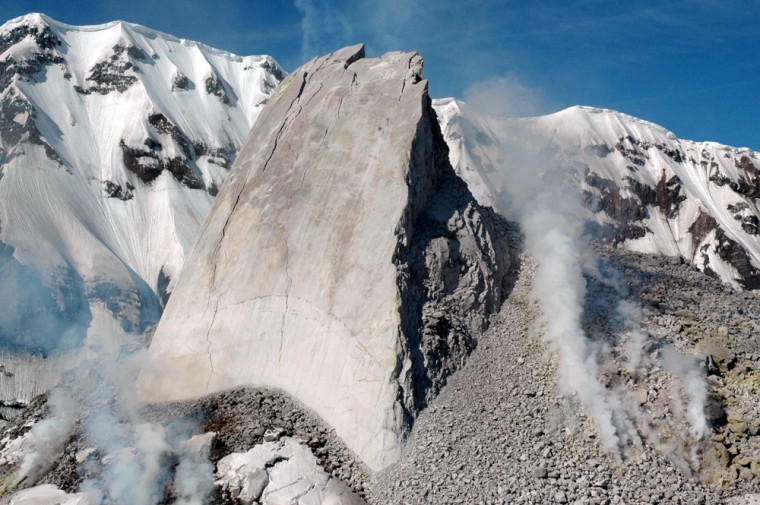If the skies are clear as forecast, volcano watchers who turn out for the reopening of the Johnston Ridge Observatory on Friday will get a spectacular view of a hulking slab of rock that's rapidly growing in Mount St. Helens' crater.
It's jutting up from one of seven lobes of fresh volcanic rock that have been pushing their way through the surface of the crater since October 2004.
The fin-shaped mass is about 300 feet tall and growing 4 feet to 5 feet a day, though it occasionally loses height from rockfalls off its tip, said Dan Dzurisin, a geologist at the U.S. Geological Survey.
It began growing last November, steadily moving west and pushing rock and other debris out of its way as it goes.
Mount St. Helens has been quietly erupting since a flurry of tiny earthquakes began in late September 2004. Scientists initially mistook the quakes as rainwater seeping into the hot interior of the older lava dome.
But it soon became clear that magma was on the move, confirmed by the emergence of fire-red lava between the old lava dome and the south crater rim a few weeks after the seismic activity began.
The volcano has continued pumping out lava ever since. Eventually, scientists expect the volcano will rebuild its conical peak that was obliterated in the May 18, 1980, eruption that killed 57 people.
The current growth of the new lava dome has been accompanied by low seismicity rates, low emissions of steam and volcanic gases and minor production of ash, the USGS said.
"Given the way things are going now, there's no hint of any sort of catastrophic eruptions," USGS geologist Tom Pierson said. "At any time, however, things can change."
Scientists flew a helicopter into the crater late last week to adjust equipment and take photographs that will likely be used to determine just how much the new lava dome has grown the last several months.
Their latest measurements, taken in December, showed that the new lava dome was about 96 million cubic yards in volume — enough to fill a football field with a stack of rock 10 1/2 miles high, Pierson said.
Scientists know the new dome is now larger than the old dome, a mass that's about 97 million cubic yards in volume that formed from a series of eruptions from 1980-1986.
"The 1980 dome frankly does not look very impressive anymore," Dzurisin said. "It's starting to disappear."
The Johnston Ridge Observatory, which closes down every winter, is the closest observatory to the 8,364-foot peak. It sits about five miles north of the mountain and offers the closest views of the volcano's horseshoe-shaped crater.
Johnston Ridge was named after David A. Johnston, a volcanologist killed in the 1980 eruption.
